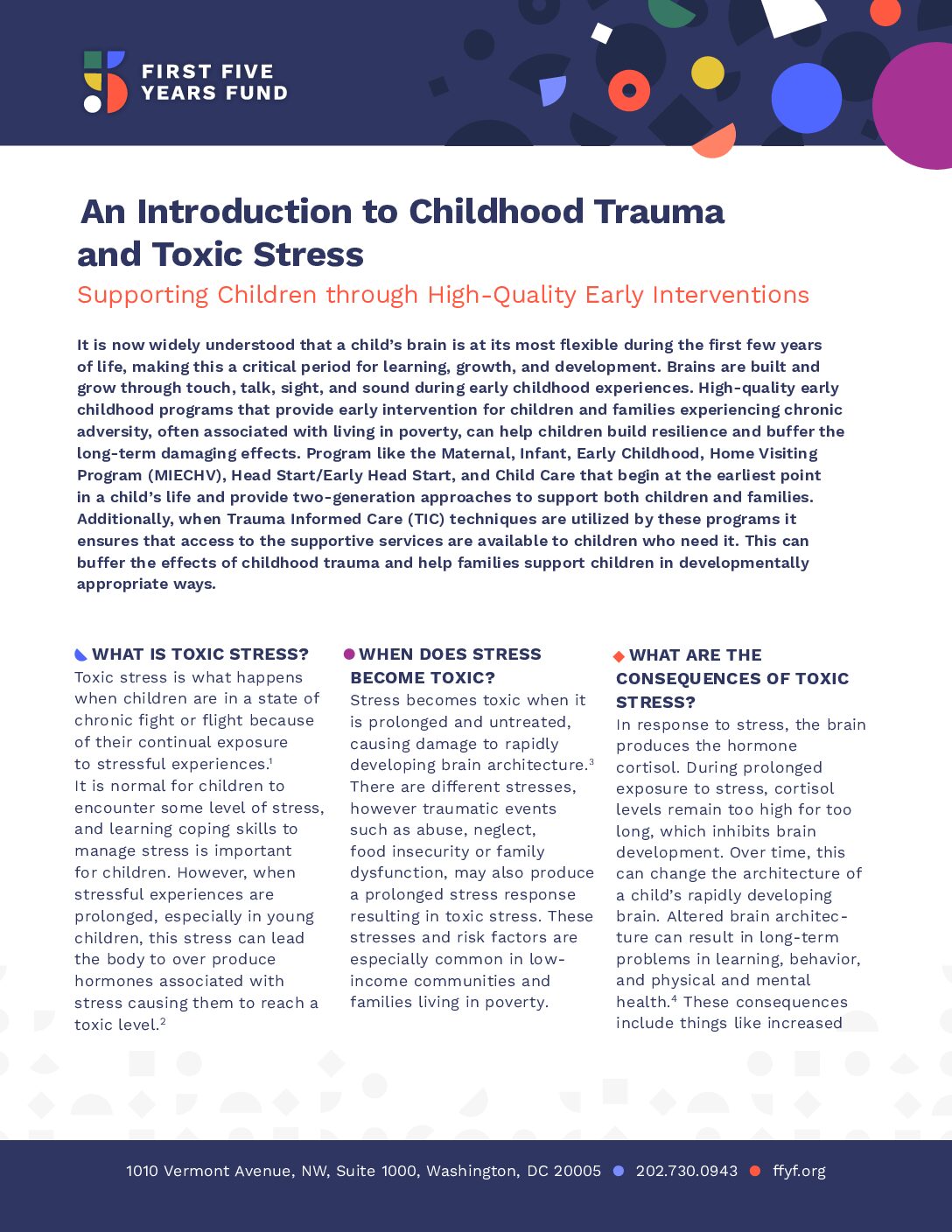An Introduction to Childhood Trauma and Toxic Stress
It is now widely understood that a child’s brain is at its most flexible during the first few years of life, making this a critical period for learning, growth, and development. Brains are built and grow through touch, talk, sight, and sound during early childhood experiences. High-quality early childhood programs that provide early intervention for children and families experiencing chronic adversity, often associated with living in poverty, can help children build resilience and buffer the long-term damaging effects.
Program like the Maternal, Infant, Early Childhood, Home Visiting Program (MIECHV), Head Start/Early Head Start, and Child Care that begin at the earliest point in a child’s life and provide two-generation approaches to support both children and families. Additionally, when Trauma Informed Care (TIC) techniques are utilized by these programs it ensures that access to the supportive services are available to children who need it. This can buffer the effects of childhood trauma and help families support children in developmentally appropriate ways.
What is toxic stress?
Toxic stress is what happens when children are in a state of chronic fight or flight because of their continual exposure to stressful experiences.[1] It is normal for children to encounter some level of stress, and learning coping skills to manage stress is important for children. However, when stressful experiences are prolonged, especially in young children, this stress can lead the body to over produce hormones associated with stress causing them to reach a toxic level.[2]
When does stress become toxic?
Stress becomes toxic when it is prolonged and untreated, causing damage to rapidly developing brain architecture.[3] There are different stresses, however traumatic events such as abuse, neglect, food insecurity or family dysfunction, may also produce a prolonged stress response resulting in toxic stress. These stresses and risk factors are especially common in low-income communities and families living in poverty.
What are the consequences of toxic stress?
In response to stress, the brain produces the hormone cortisol. During prolonged exposure to stress, cortisol levels remain too high for too long, which inhibits brain development. Over time, this can change the architecture of a child’s, rapidly developing brain. Altered brain architecture can result in long-term problems in learning, behavior, and physical and mental health.[4] These consequences include things like increased risk for substance misuse, liver disease, poor academic achievement, and reduced executive function or ability to self-regulate behavior.[5]
How can toxic stress be identified?
There are a number of ways to identify toxic stress, but one critical tool is the Adverse Childhood Experiences (ACEs) test.Adverse Childhood Experiences (ACEs) are characterized as traumatic events that occur during childhood. These include events such as abuse, neglect, family separation, or living with a parent with mental illness or substance use disorder. Any of these experiences can have a profound effect on children and can lead to the development of toxic stress.[6] A child’s ACE Score is determined by how many ACEs he or she has experienced, and can be a predictor of physical, social and emotional problems later in life.
While many people may think of exposure to ACEs as isolated and only affecting a small number of children, at least half of children in the United States have experienced one or more ACEs in their life.[7] Moreover, 62% of children living in poverty experience ACEs, which is a significantly higher rate than their affluent peers. And children living in poverty are more likely to experience multiple ACEs.[8] Research finds that the more ACEs a child experiences the more likely they are to have negative outcomes later in life.[9]
How can we combat the negative effects of toxic stress?
Research shows that the best ways to buffer the effects of ACEs and toxic stress are to stop or reduce a child’s exposure to the stressful condition, begin providing stable conditions for the child, and ensure that the child has a responsive relationship with as many caring adults as early as possible. In addition to these interventions, children may benefit from professional therapeutic help after a traumatic event.
Ensuring that any interventions and support given to children exposed to trauma is high-quality and evidence-based is critical to helping children cope with and buffer the effects of toxic stress.
Conclusion
Children’s brains develop rapidly during the first years of life laying the crucial foundation for their future brain architecture. Federal programs such as MIECHV, Head Start, and child care, in addition to many other evidence-based interventions, can support children and families to help reduce risks and support children’s healthy development. Additionally, these programs provide stable, supportive relationships with adults to the children they serve. Those relationships are a key component of mitigating the effects of toxic stress on children. In the absence of those important relationships, children’s brain development is altered which can lead to long-term negative behavioral, physical, and mental health outcomes.
States and localities can also leverage federal funding to help children and families who experience toxic stress. Some states have used the funding to provide professional development to child care workers in order to equip them with the skills they need to provide care that is sensitive to child trauma. High quality early learning is critical to ensuring that children are receiving developmentally appropriate care in a supportive environment. These relationships can provide lasting benefits to children who are facing adverse experiences in other aspects of their lives.
[1] The Hechinger Report: Child Victims of Toxic Stress Face a Long Road to Healing https://hechingerreport.org/opinion-child-victims-of-toxic-stress-face-a-long-road-to-healing/?mc_cid=a1035ae9ec&mc_eid=fcaa27ec36
[2] Harvard University Center on the Developing Child: Toxic Stress https://developingchild.harvard.edu/science/key-concepts/toxic-stress/
[3] Harvard University Center on the Developing Child: Toxic Stress https://developingchild.harvard.edu/science/key-concepts/toxic-stress/
[4] Harvard University Center on the Developing Child: Toxic Stress https://developingchild.harvard.edu/science/key-concepts/toxic-stress/
[5] The Centers for Disease Control and Prevention: About the CDC-Kaiser ACE Study https://www.cdc.gov/violenceprevention/acestudy/about.html
[6] Child Trends: The prevalence of adverse childhood experiences, nationally, by state, and by race or ethnicity https://www.childtrends.org/publications/prevalence-adverse-childhood-experiences-nationally-state-race-ethnicity
[7] Child Trends: Helping Young Children Who Have Experienced Trauma: Policies and Strategies for Early Care and Education – Executive Summary https://www.childtrends.org/publications/ecetraumaexecsum
[8] Robert Wood Johnson Foundation: Traumatic Experiences Widespread Among US Youth, New Data Shows https://www.rwjf.org/en/library/articles-and-news/2017/10/traumatic-experiences-widespread-among-u-s–youth–new-data-show.html
[9] The Centers for Disease Control and Prevention: About the CDC-Kaiser ACE Study https://www.cdc.gov/violenceprevention/acestudy/about.html
[10] Harvard University Center on the Developing Child: ACEs and Toxic Stress: Frequently Asked Questions https://developingchild.harvard.edu/resources/aces-and-toxic-stress-frequently-asked-questions/
Subscribe to FFYF First Look
Every morning, FFYF reports on the latest child care & early learning news from across the country. Subscribe and take 5 minutes to know what's happening in early childhood education.



